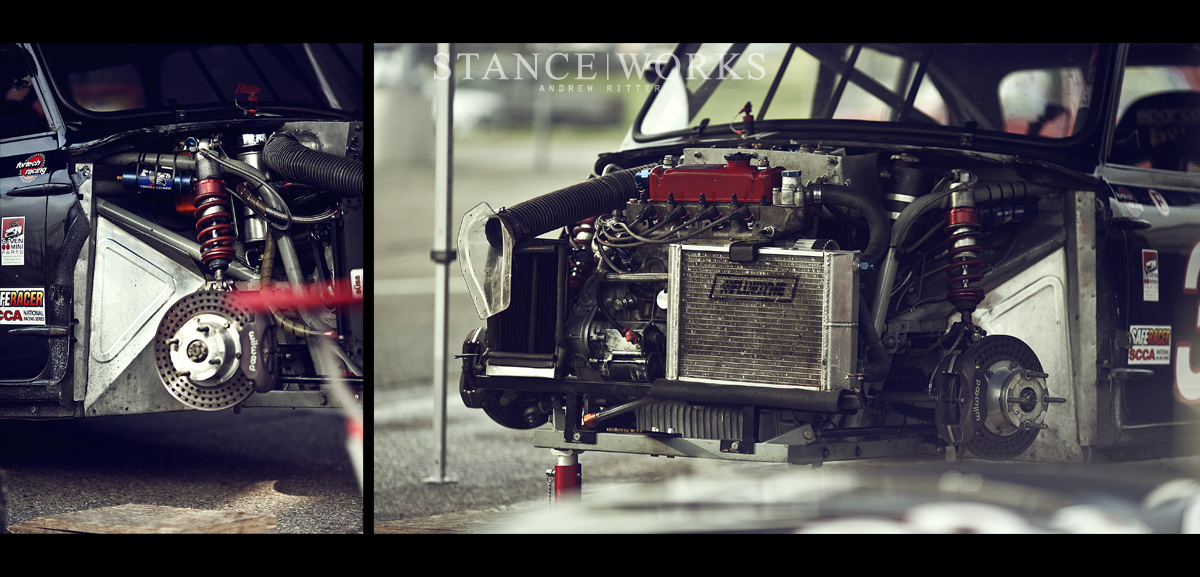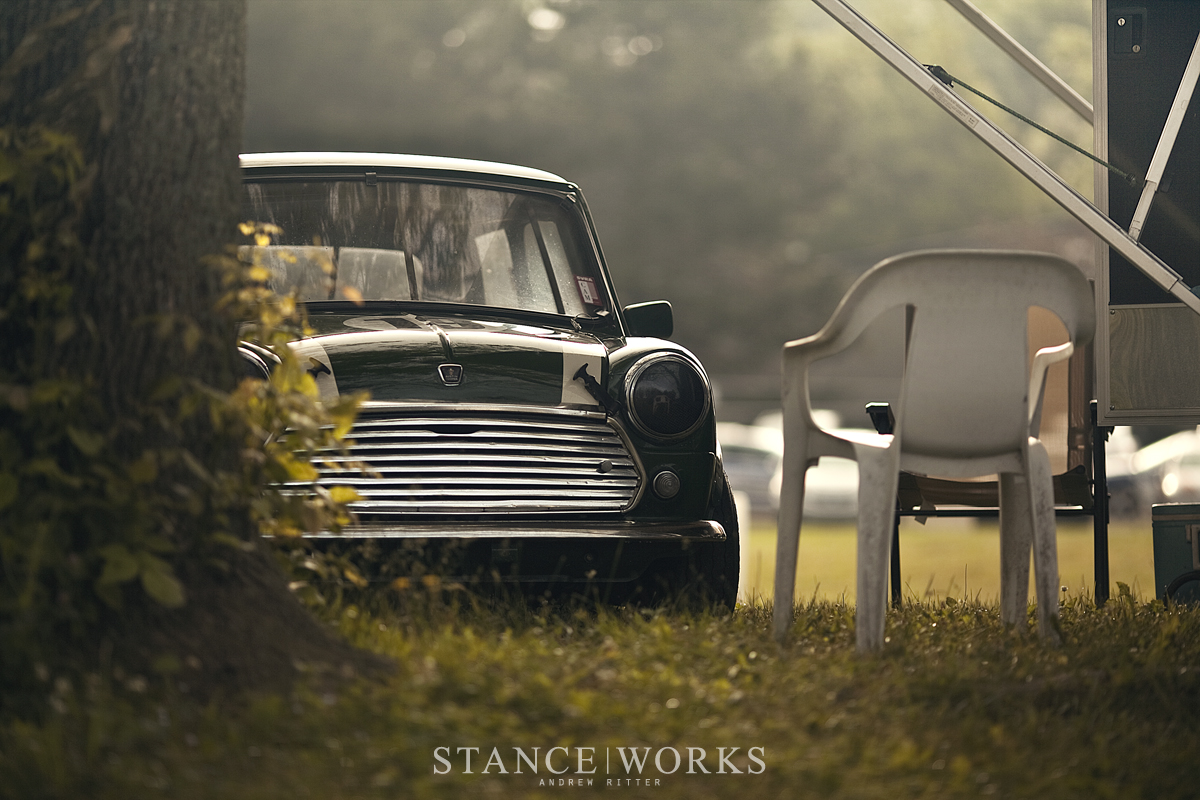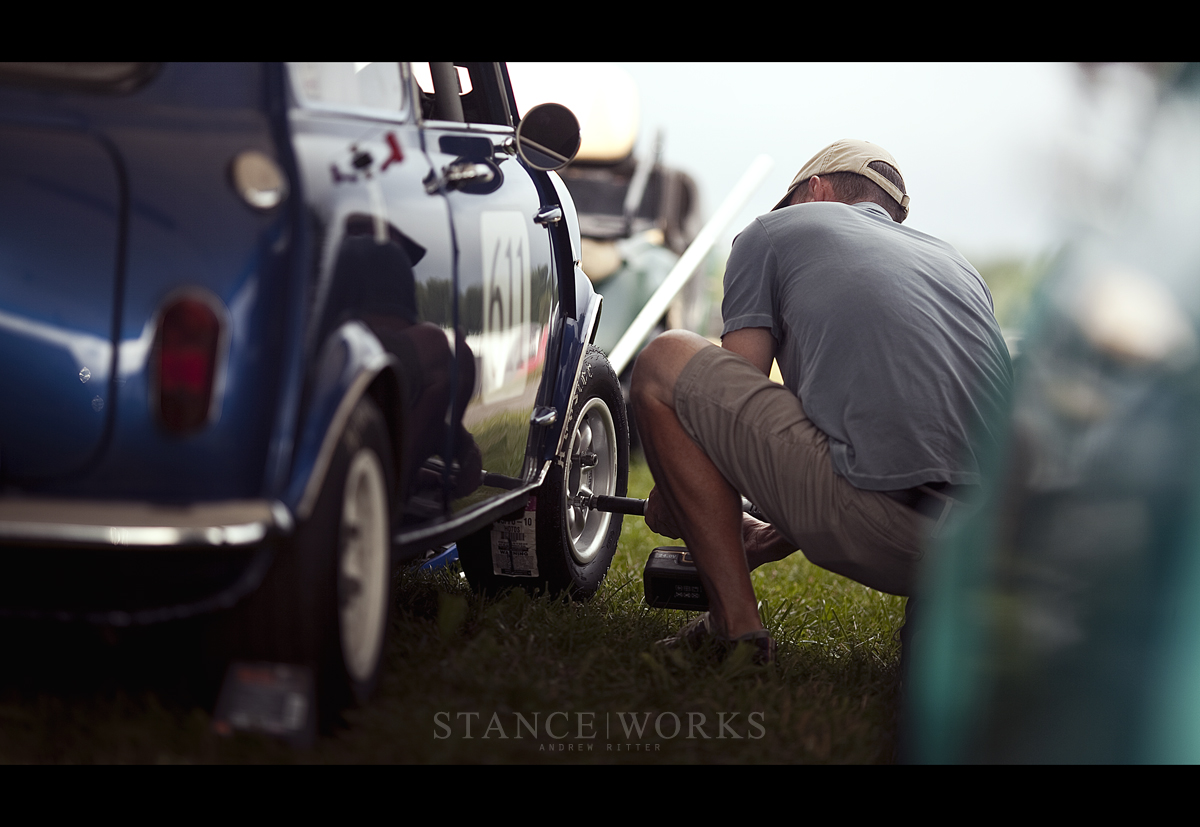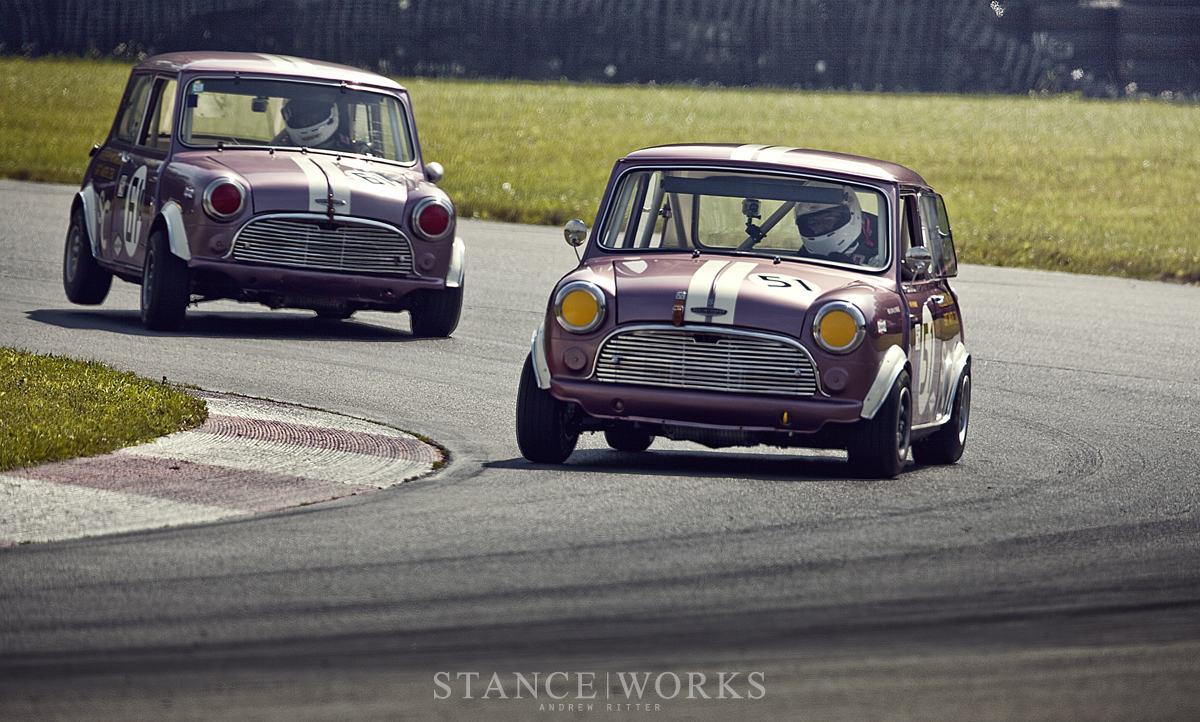The legacy started decades ago in the United Kingdom. The Suez Crisis left the UK to ration fuel once again, and sales of large vehicles began to plummet. In response to the fuel shortage, Sir Alec Issigonis was tasked with the challenge of developing a small, efficient car that was still capable of transporting 4 adults and their luggage. Utilizing the British Motor Company’s existing A-Series engine in an innovative transverse position, Issigonis’s Mini was the first front-wheel-drive production car, and would later influence the design of many FWD platforms to follow. In August of 1959, BMC publicly announced the release of the Mini, and in the following years, it would have a profound effect on the automotive world, leaving a lasting impression on the way we view transportation and motorsports.
The famous racecar driver and friend of Sir Alec Issigonis, John Cooper, began to take notice of the sports car qualities that the Mini hid behind its quirky exterior. Originally designed as an exercise in efficient transportation, the light weight, wide track, low center of gravity, and stiff suspension also held great possibilities for a true competitor. Within the first year, John Cooper was already testing the capabilities of the little car, and by 1960 he found himself impressed by its performance in the Monte Carlo Rally. Seeing the initial success, the two began working together to improve upon the performance aspects of the Mini. By 1964, just 5 years after its initial launch, the Mini began it’s domination at the Monte Carlo rally. Throughout the ’60s, the Mini was a regular on the podium at many of the European rallies, and it proved itself on the road circuits. While the Mini enjoyed many great motorsport successes in Europe, it wasn’t long before the Minis found their way to North America to compete amongst the great American road courses.
Fast forward 5 decades, and there I stood, at Mid Ohio once again. The day started as all good race days seem to start. The fog lifted off the hills, the dew dripped down windshields, and the paddocks sprang to life as I had witnessed so many times before, but this morning was particularly special. The central paddock buzzed with the chorus of 998s, 1275s, and 1380s as the Minis began their morning warm up. It was the first morning of the Can-Am Mini Challenge, and the festitivies were about to start. I was surrounded by over 40 classic Mini race cars and I can’t think of many other places I’d rather be.
For so many of the cars, this was a reunion of sorts. It was an opportunity to get back to the track and share the grid with familiar competitors from years past. With lengthy histories in competition, the Minis were preparing to put another notch in their belts and compete in a sprint race on the technical road course that winds through the hilly landscape of Lexington, Ohio. Since its inception, the Mini has spent its years with all four tires squealing around corners and flying through rally courses, so it was fitting that we’d all traveled back to the track to celebrate the 55th anniversary of the car that we all love.
With practice laps underway, I found my eyes glued to the M5 class. Comprised of the cars that competed in the GT5 class of SCCA competition, their tube frames and wide flared composite body panels gave them a presence that stood out at the front of the pack. The yellow car, emblazened with its Seven Enterprises logo and purple roof top was the first to capture my attention. Doug Peterson returned to the right-hand-drive driver’s seat of the number 11 GT5 Fortech Mini and skillfully careened down the Esses that followed the back straight. Pumping out 147 horespower from the 1380cc A-Series, the Fortech car is a 1300 pound fiberglass and carbon fiber sillouhette of the other Minis that circled Mid-Ohio. In 1986, Comptech built the tube frame, and that same year, Fortech Racing took home the GT5 National Champion title at the SCCA Runoffs. With 3 more GT5 National Championship wins in 1989, 2003, and 2004, the Fortech Mini established itself in the world of SCCA and has continued to compete ever since, racking up over 72 wins and 110 races in its log books.
This wasn’t the first time that the Fortech Mini vied for the inside line of Mid-Ohio’s complex turns against the sinister, black Huffaker Engineering car. For years, Doug Peterson and Joe Huffaker returned to Mid-Ohio to compete for the GT5 title at the SCCA Runoffs. The Huffaker Mini, built later in 1997, was able to utilize new rules to turn the A-Series engine inline and build the first RWD GT5 Mini. Its more modern design gave it a leg up on the competition and it took home the championship in 2000, 2001, and 2002. The hard fought battle between the two was surely entertaining each year, with Fortech managing the wins in 2003 and 2004 when the Huffaker Mini DNF’d. 10 years later and both the cars and drivers had returned and were locked in friendly competition once again.
Lap after lap, the Huffaker Mini ran strong through the corners and accelerated out with a roar. By the end of Saturday, Joe had managed an incredible 1:40.605 lap time and positioned himself at the pole for Sunday’s Can-Am Mini Challenge Race. It was quite the spectacle to watch the low slung GT5 cars navigate the course with ease, but perhaps even more astounding was the Wedgewood Blue Austin Cooper S that was in the middle of the GT5 pack. Seemingly a standard chassis car, it was keeping up with the big dogs and putting down comparable lap times just seconds behind the leader. The 1963 Austin Cooper S was an old SCCA racer with a lengthy history in motorsports, told through the multiple layers of livery paint that hid beneath the baby blue. Registered under ‘129 LNP’, the car was purchased by Bob Kimes, a famous SCCA Competitor, after it was brought over from the UK to compete in North America. There’s is still plenty of research to be done to unearth the complete history of the car, but there’s no doubt that it had been putting in its time at the track from the mid 1960s until the early 90s. Andy and Rachel Nelson of Toybox Racing (and the wonderful organizers of this event) recently restored the racecar to the beautiful condition that I saw circling the track with an impressive quickness. Behind the wheel was Nick Swift from Swiftune Engineering in the UK. Swiftune, a company that has been building championship winning A-series engines for nearly 50 years, built up quite a powerhouse for the restored Austin. The 1310cc engine matched with a properly setup chassis and Nick Swift’s driving talent were enough to secure the second position in the grid for raceday, just 1.5 seconds behind the Huffaker car at pole.
While Nick Swift piloted the number 52 car through Thunder Valley, Andy Nelson was at the wheel of the other Toybox Racing car in attendance, the number 68 Cooper S. The car was originally built in 1965, and by 1966 the original owner, Gordon “Red” Schimberg, had already earned a spot on the grid of the American Road Race of Champions in Riverside, California. In 1967, the Mini continued its racing career onward and reached the ARRC once again in Daytona Florida. While the number 68 car continued racing up until ’71, its attendance at the Daytona International Speedway in 1967 was of particular importance this weekend. The Can-Am Mini Challenge was the exact excuse that was needed to dust off some of the Minis that raced on that weekend in 67. 47 years later, the Minis were reunited to stretch their legs and compete just like they had at the ARRC.
In addition to the number 68 and number 52 cars, campaigned by Toybox Racing, the number 37 Morris Mini came to Ohio for the ’67 ARRC reunion. As class rules changed, so did the appearances of each car, and the 37 arrived at Mid-Ohio with a newly restored livery harking back to its old GT trim, but it was another ex-Bob Kimes car that had raced around Daytona with the others. John Wittenauer now competes in various vintage races with the Morris under its new period-correct Marathon livery, keeping its legacy alive.
It’s hard to miss the purple Overseas Motor Minis as they scoot around the track, often one after the other in unison. It was a blast to watch the matching pair slide around the Carousel, and at the heart of it, that fun is what racing Minis is about. But, with the quirkiness of the well known “Purple People Eater” livery set aside, these two cars were serious competitors in the 60s. Amidst a long list of motorsport accomplishments, the duo was on grid for the 1967 Daytona ARRC along side the others in attendance this weekend. After starting out in 9th place, Richard McDaniels drove the “Purple People Eater” right to the Podium in ’67: one of his three first place finishes at the SCCA ARRC in the late 60s. Robert Hoemeke later purchased McDaniels’s winning car and had been preserving it for a years before recently finding its sister car in 2012. In disarray and showing signs of its age, the second car went up to Seven Enterprises where Mike Kearney restored it to its prior glory. Upon completion of the period restoration, the two cars joined each other once again to compete at the Monterey Reunion at Laguna Seca before arriving this weekend at Mid-Ohio for the Mini Challenge.
Mark Kearney, Mike’s brother, rounded the course in the Seven Enterprises “Tribute Mini”, flying the British Racing Green and White livery of the old Cooper Car Co. cars. Dating back to John Cooper and his father Charles, the Cooper Car Co. was first forged in Formula racing and later dominated with their Minis, playing a vital role in the Mini’s motorsport lineage that grew from there. It seemed fitting to see a tribute of the well known Cooper stripes coming around the bend before blasting down the next straight.
For some, this weekend was the motivating factor to reinvigorate the retired racers that sat dormant in sheds and garages to return to the tarmac they had once frequented. Upon hearing the news of an upcoming Mini Challenge, owner and driver, Dan Hill, returned to his old racecar and set out to prepare for its first outing since September of 1987. With its special one-off box fender flares and classic colorway, it was great to see a Mini come back to life and do what it had always done best.
Another set of Californians had accompanied me in the trek across the country for this long awaited weekend. Don and Dennis of Mini Mania had brought their cars out east, and they were carrying serious speed through the corners. The Monte Mini, as they call it, was built as a tribute to the 1967 Monte Carlo Rallye winner driven by Rauno Aaltonen, but since being built in 1982 it has built it up its own impressive list of race entries, totaling over 100 so far. While Dennis was setting his best lap times in the rally racer, Don was at the wheel of the bright yellow 61 car, lifting the inside rear wheel around the corners. The car was originally owned and raced by John Unsbee and it still carried the Peace Sign headlight tape that were a part of Unsbee’s controversial ways as he raced his way to an SCCA C-Sedan class Championship win in 1972.
With 47 cars lined up in the grid for the final race day, it’s far too many for me to recount in this short article, but on that Sunday, a group of drivers and a crowd of spectators celebrated the long motorsport history of the Mini. For 55 years, Minis have filled the paddocks and traversed rally courses around the world, so when the full line-up buzzed by me on their first lap, I couldn’t help but smile. The race heritage of these Minis was still being upheld and their drivers were still on the track, appreciating the characteristics of the Mini and its A-Series engine that made it such a competitor to begin with. After 15 minutes of tire squealing and exhaust burbles, Joe Huffaker drove his GT5 right into first place followed closely behind by Nick Swift in the 129-LNP restoration in second and Chris Kopley’s Silver GT-L Mini in third. The checkered flag marked the end of an incredible weekend. Hopefully these Minis and their drivers will continue to compete for many years to come. I know I’ll be right there to cheer them on as they do and perhaps one day I’ll join them on the track to celebrate the Mini’s prowess.






























